KIA RIO HATCHBACK 2008 Owners Manual
Manufacturer: KIA, Model Year: 2008, Model line: RIO HATCHBACK, Model: KIA RIO HATCHBACK 2008Pages: 219, PDF Size: 5.17 MB
Page 171 of 219
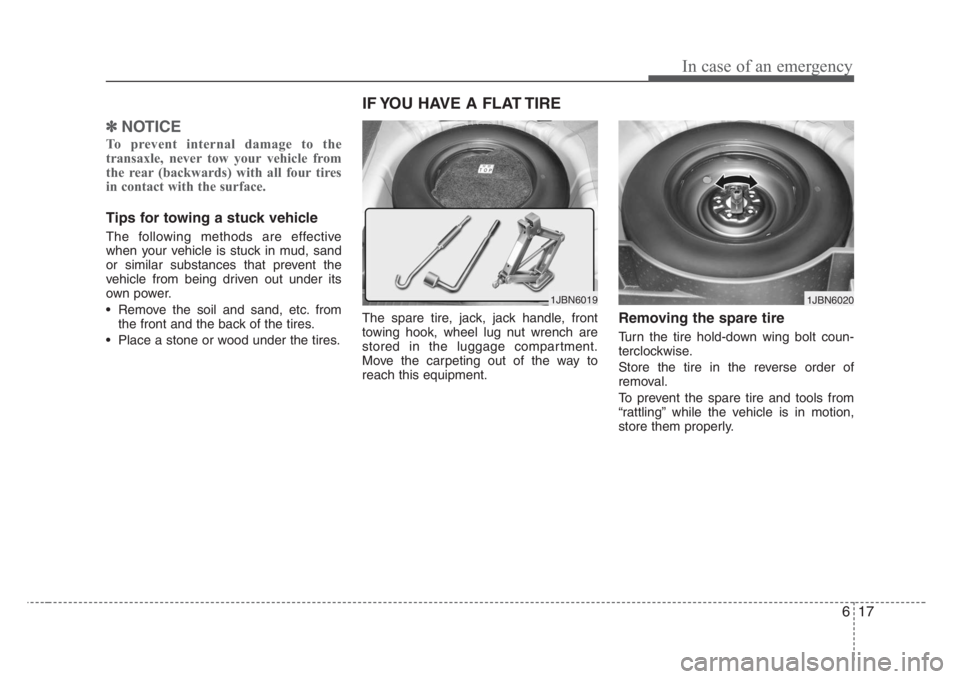
617
In case of an emergency
✽
NOTICE
To prevent internal damage to the
transaxle, never tow your vehicle from
the rear (backwards) with all four tires
in contact with the surface.
Tips for towing a stuck vehicle
The following methods are effective
when your vehicle is stuck in mud, sand
or similar substances that prevent the
vehicle from being driven out under its
own power.
• Remove the soil and sand, etc. from
the front and the back of the tires.
• Place a stone or wood under the tires.The spare tire, jack, jack handle, front
towing hook, wheel lug nut wrench are
stored in the luggage compartment.
Move the carpeting out of the way to
reach this equipment.
Removing the spare tire
Turn the tire hold-down wing bolt coun-
terclockwise.
Store the tire in the reverse order of
removal.
To prevent the spare tire and tools from
“rattling” while the vehicle is in motion,
store them properly.
IF YOU HAVE A FLAT TIRE
1JBN60191JBN6020
Page 172 of 219
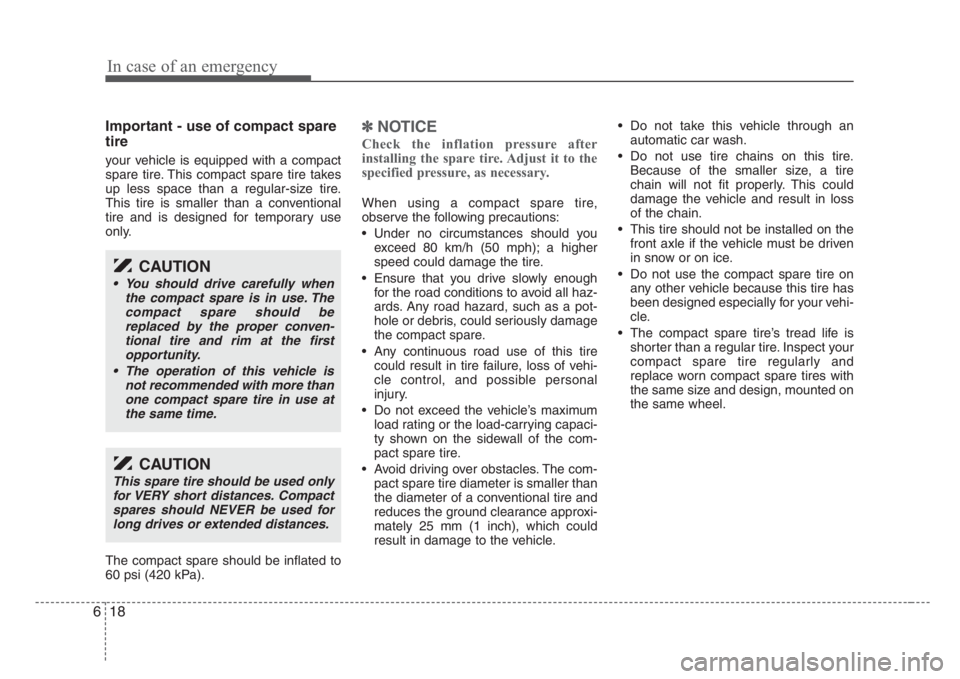
In case of an emergency
18 6
Important - use of compact spare
tire
your vehicle is equipped with a compact
spare tire. This compact spare tire takes
up less space than a regular-size tire.
This tire is smaller than a conventional
tire and is designed for temporary use
only.
The compact spare should be inflated to
60 psi (420 kPa).
✽
NOTICE
Check the inflation pressure after
installing the spare tire. Adjust it to the
specified pressure, as necessary.
When using a compact spare tire,
observe the following precautions:
• Under no circumstances should you
exceed 80 km/h (50 mph); a higher
speed could damage the tire.
• Ensure that you drive slowly enough
for the road conditions to avoid all haz-
ards. Any road hazard, such as a pot-
hole or debris, could seriously damage
the compact spare.
• Any continuous road use of this tire
could result in tire failure, loss of vehi-
cle control, and possible personal
injury.
• Do not exceed the vehicle’s maximum
load rating or the load-carrying capaci-
ty shown on the sidewall of the com-
pact spare tire.
• Avoid driving over obstacles. The com-
pact spare tire diameter is smaller than
the diameter of a conventional tire and
reduces the ground clearance approxi-
mately 25 mm (1 inch), which could
result in damage to the vehicle.• Do not take this vehicle through an
automatic car wash.
• Do not use tire chains on this tire.
Because of the smaller size, a tire
chain will not fit properly. This could
damage the vehicle and result in loss
of the chain.
• This tire should not be installed on the
front axle if the vehicle must be driven
in snow or on ice.
• Do not use the compact spare tire on
any other vehicle because this tire has
been designed especially for your vehi-
cle.
• The compact spare tire’s tread life is
shorter than a regular tire. Inspect your
compact spare tire regularly and
replace worn compact spare tires with
the same size and design, mounted on
the same wheel.
CAUTION
• You should drive carefully when
the compact spare is in use. The
compact spare should be
replaced by the proper conven-
tional tire and rim at the first
opportunity.
• The operation of this vehicle is
not recommended with more than
one compact spare tire in use at
the same time.
CAUTION
This spare tire should be used only
for VERY short distances. Compact
spares should NEVER be used for
long drives or extended distances.
Page 173 of 219
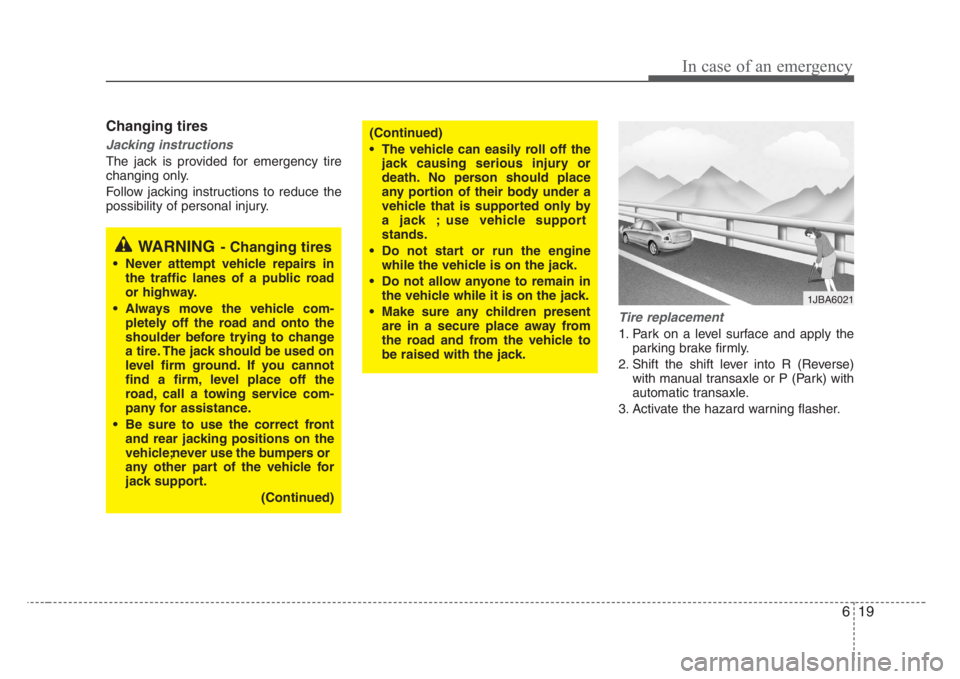
619
In case of an emergency
Changing tires
Jacking instructions
The jack is provided for emergency tire
changing only.
Follow jacking instructions to reduce the
possibility of personal injury.
Tire replacement
1. Park on a level surface and apply the
parking brake firmly.
2. Shift the shift lever into R (Reverse)
with manual transaxle or P (Park) with
automatic transaxle.
3. Activate the hazard warning flasher.
WARNING- Changing tires
• Never attempt vehicle repairs in
the traffic lanes of a public road
or highway.
•Always move the vehicle com-
pletely off the road and onto the
shoulder before trying to change
a tire. The jack should be used on
level firm ground. If you cannot
find a firm, level place off the
road, call a towing service com-
pany for assistance.
• Be sure to use the correct front
and rear jacking positions on the
vehicle;never use the bumpers or
any other part of the vehicle for
jack support.
(Continued)
(Continued)
• The vehicle can easily roll off the
jack causing serious injury or
death. No person should place
any portion of their body under a
vehicle that is supported only by
a jack ; use vehicle support
stands.
• Do not start or run the engine
while the vehicle is on the jack.
• Do not allow anyone to remain in
the vehicle while it is on the jack.
• Make sure any children present
are in a secure place away from
the road and from the vehicle to
be raised with the jack.
1JBA6021
Page 174 of 219
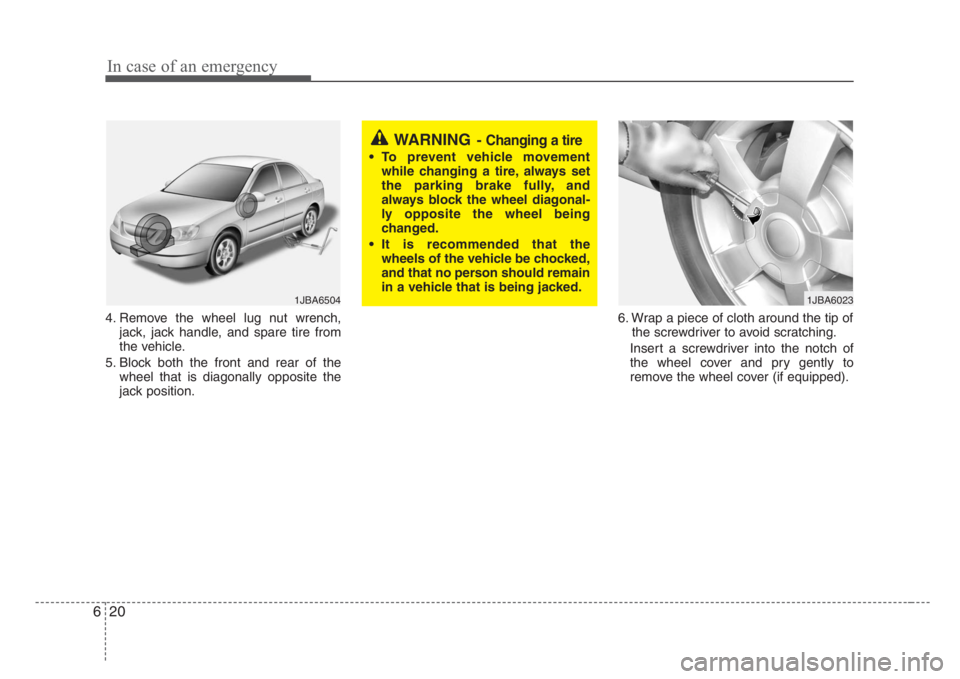
In case of an emergency
20 6
4. Remove the wheel lug nut wrench,
jack, jack handle, and spare tire from
the vehicle.
5. Block both the front and rear of the
wheel that is diagonally opposite the
jack position.6. Wrap a piece of cloth around the tip of
the screwdriver to avoid scratching.
Insert a screwdriver into the notch of
the wheel cover and pry gently to
remove the wheel cover (if equipped).
WARNING-Changing a tire
• To prevent vehicle movement
while changing a tire, always set
the parking brake fully, and
always block the wheel diagonal-
ly opposite the wheel being
changed.
• It is recommended that the
wheels of the vehicle be chocked,
and that no person should remain
in a vehicle that is being jacked.
1JBA65041JBA6023
Page 175 of 219
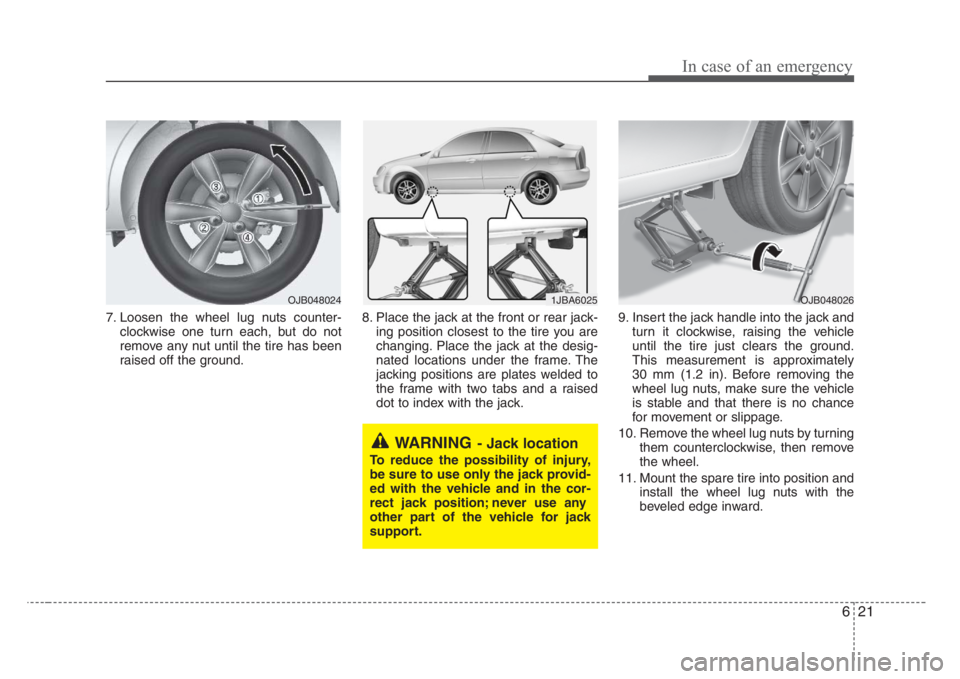
621
In case of an emergency
7. Loosen the wheel lug nuts counter-
clockwise one turn each, but do not
remove any nut until the tire has been
raised off the ground.8. Place the jack at the front or rear jack-
ing position closest to the tire you are
changing. Place the jack at the desig-
nated locations under the frame. The
jacking positions are plates welded to
the frame with two tabs and a raised
dot to index with the jack.9. Insert the jack handle into the jack and
turn it clockwise, raising the vehicle
until the tire just clears the ground.
This measurement is approximately
30 mm (1.2 in). Before removing the
wheel lug nuts, make sure the vehicle
is stable and that there is no chance
for movement or slippage.
10. Remove the wheel lug nuts by turning
them counterclockwise, then remove
the wheel.
11. Mount the spare tire into position and
install the wheel lug nuts with the
beveled edge inward.
1JBA6025
WARNING- Jack location
To reduce the possibility of injury,
be sure to use only the jack provid-
ed with the vehicle and in the cor-
rect jack position; never use any
other part of the vehicle for jack
support.
OJB048026OJB048024
Page 176 of 219
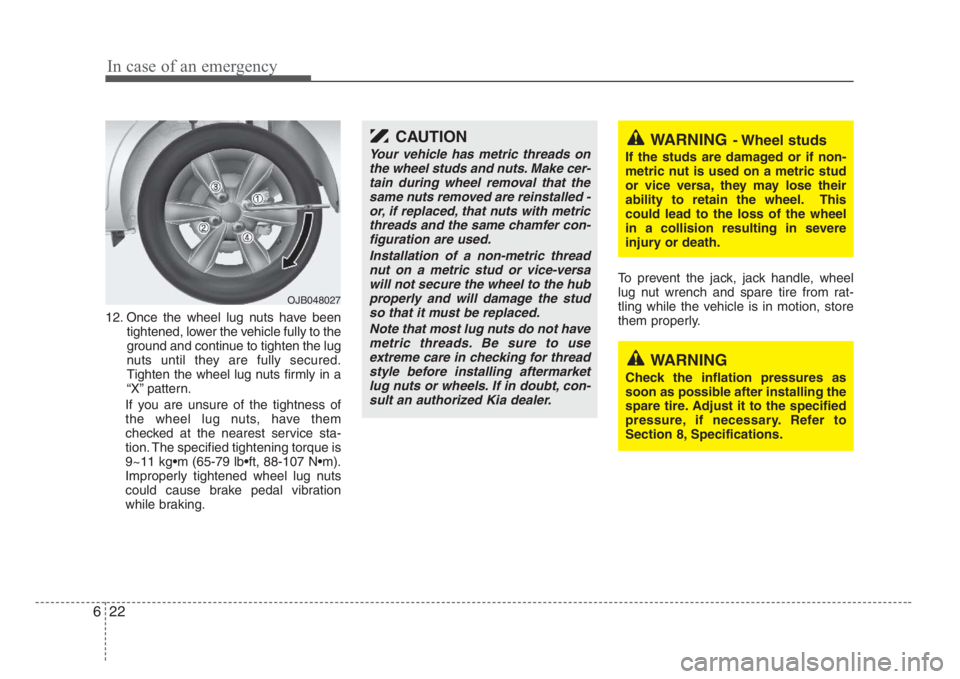
In case of an emergency
22 6
12. Once the wheel lug nuts have been
tightened, lower the vehicle fully to the
ground and continue to tighten the lug
nuts until they are fully secured.
Tighten the wheel lug nuts firmly in a
“X” pattern.
If you are unsure of the tightness of
the wheel lug nuts, have them
checked at the nearest service sta-
tion. The specified tightening torque is
9~11 kg•m (65-79 lb•ft, 88-107 N•m).
Improperly tightened wheel lug nuts
could cause brake pedal vibration
while braking.To prevent the jack, jack handle, wheel
lug nut wrench and spare tire from rat-
tling while the vehicle is in motion, store
them properly.
CAUTION
Your vehicle has metric threads on
the wheel studs and nuts. Make cer-
tain during wheel removal that the
same nuts removed are reinstalled -
or, if replaced, that nuts with metric
threads and the same chamfer con-
figuration are used.
Installation of a non-metric thread
nut on a metric stud or vice-versa
will not secure the wheel to the hub
properly and will damage the stud
so that it must be replaced.
Note that most lug nuts do not have
metric threads. Be sure to use
extreme care in checking for thread
style before installing aftermarket
lug nuts or wheels. If in doubt, con-
sult an authorized Kia dealer.
WARNING- Wheel studs
If the studs are damaged or if non-
metric nut is used on a metric stud
or vice versa, they may lose their
ability to retain the wheel. This
could lead to the loss of the wheel
in a collision resulting in severe
injury or death.
WARNING
Check the inflation pressures as
soon as possible after installing the
spare tire. Adjust it to the specified
pressure, if necessary. Refer to
Section 8, Specifications.
OJB048027
Page 177 of 219
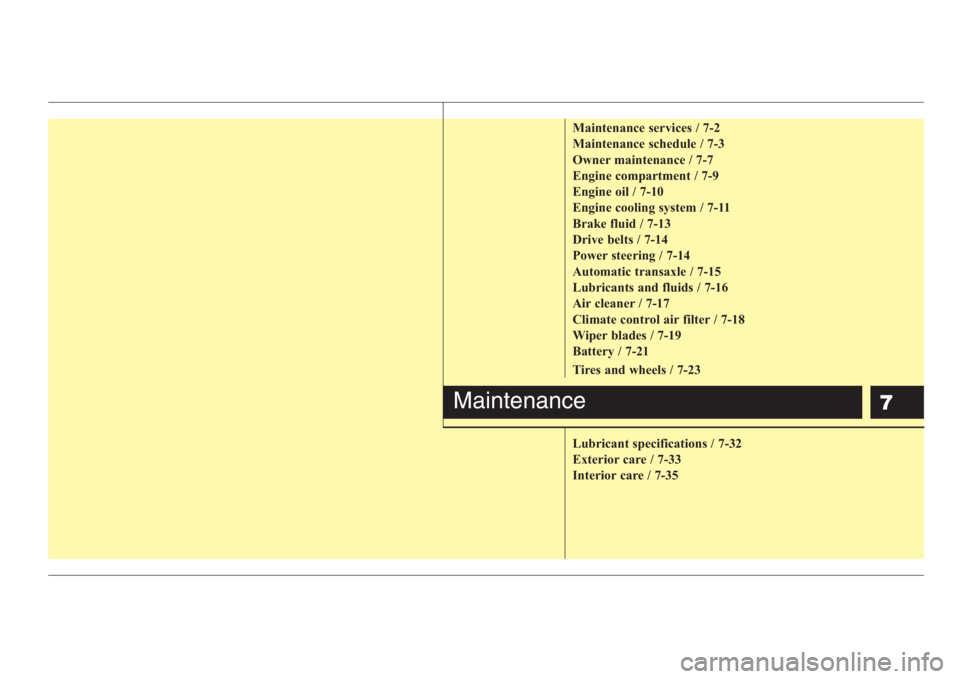
7
Maintenance services / 7-2
Maintenance schedule / 7-3
Owner maintenance / 7-7
Engine compartment / 7-9
Engine oil / 7-10
Engine cooling system / 7-11
Brake fluid / 7-13
Drive belts / 7-14
Power steering / 7-14
Automatic transaxle / 7-15
Lubricants and fluids / 7-16
Air cleaner / 7-17
Climate control air filter / 7-18
Wiper blades / 7-19
Battery / 7-21
Tires and wheels / 7-23
Lubricant specifications / 7-32
Exterior care / 7-33
Interior care / 7-35
Maintenance
Page 178 of 219
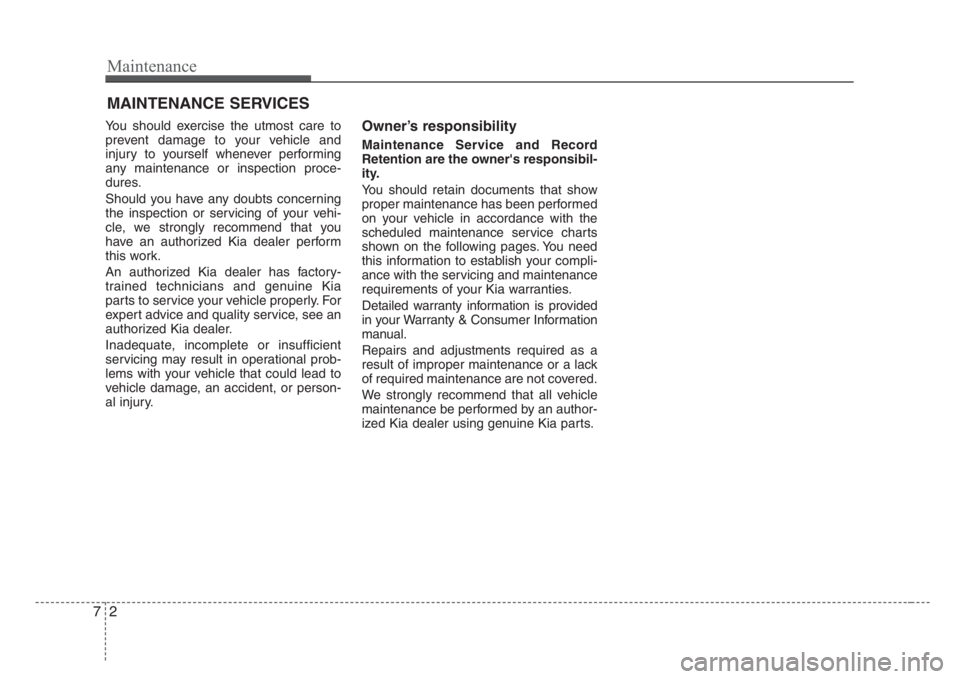
Maintenance
2 7
MAINTENANCE SERVICES
You should exercise the utmost care to
prevent damage to your vehicle and
injury to yourself whenever performing
any maintenance or inspection proce-
dures.
Should you have any doubts concerning
the inspection or servicing of your vehi-
cle, we strongly recommend that you
have an authorized Kia dealer perform
this work.
An authorized Kia dealer has factory-
trained technicians and genuine Kia
parts to service your vehicle properly. For
expert advice and quality service, see an
authorized Kia dealer.
Inadequate, incomplete or insufficient
servicing may result in operational prob-
lems with your vehicle that could lead to
vehicle damage, an accident, or person-
al injury.Owner’s responsibility
Maintenance Service and Record
Retention are the owner's responsibil-
ity.
You should retain documents that show
proper maintenance has been performed
on your vehicle in accordance with the
scheduled maintenance service charts
shown on the following pages. You need
this information to establish your compli-
ance with the servicing and maintenance
requirements of your Kia warranties.
Detailed warranty information is provided
in your Warranty & Consumer Information
manual.
Repairs and adjustments required as a
result of improper maintenance or a lack
of required maintenance are not covered.
We strongly recommend that all vehicle
maintenance be performed by an author-
ized Kia dealer using genuine Kia parts.
Page 179 of 219
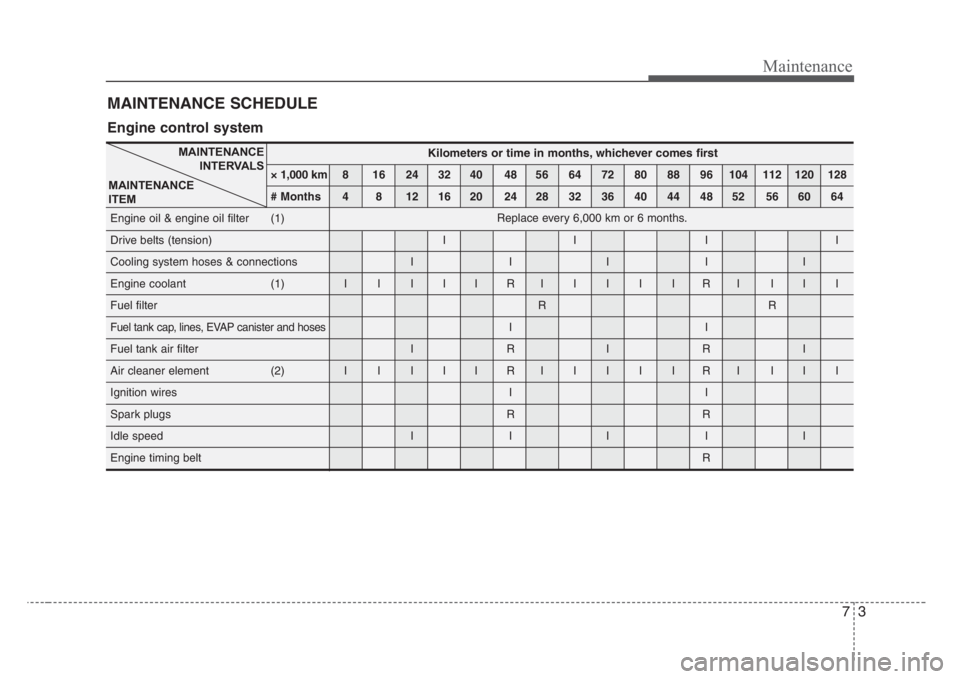
73
Maintenance
MAINTENANCE SCHEDULE
Engine control system
Kilometers or time in months, whichever comes first
× 1,000 km 8 16 24 32 40 48 56 64 72 80 88 96 104 112 120 128
# Months4 8 12 16 20 24 28 32 36 40 44 48 52 56 60 64
Engine oil & engine oil filter (1)
Drive belts (tension) I I I I
Cooling system hoses & connections I I I I I
Engine coolant (1) I I I I I RIIIIIRI III
Fuel filterRR
Fuel tank cap, lines, EVAP canister and hosesII
Fuel tank air filter I R I R I
Air cleaner element (2) I I I I I RIIIIIRI III
Ignition wires I I
Spark plugs R R
Idle speed I I I I I
Engine timing beltR
MAINTENANCE
INTERVALS
MAINTENANCE
ITEM
Replace every 6,000 km or 6 months.
Page 180 of 219
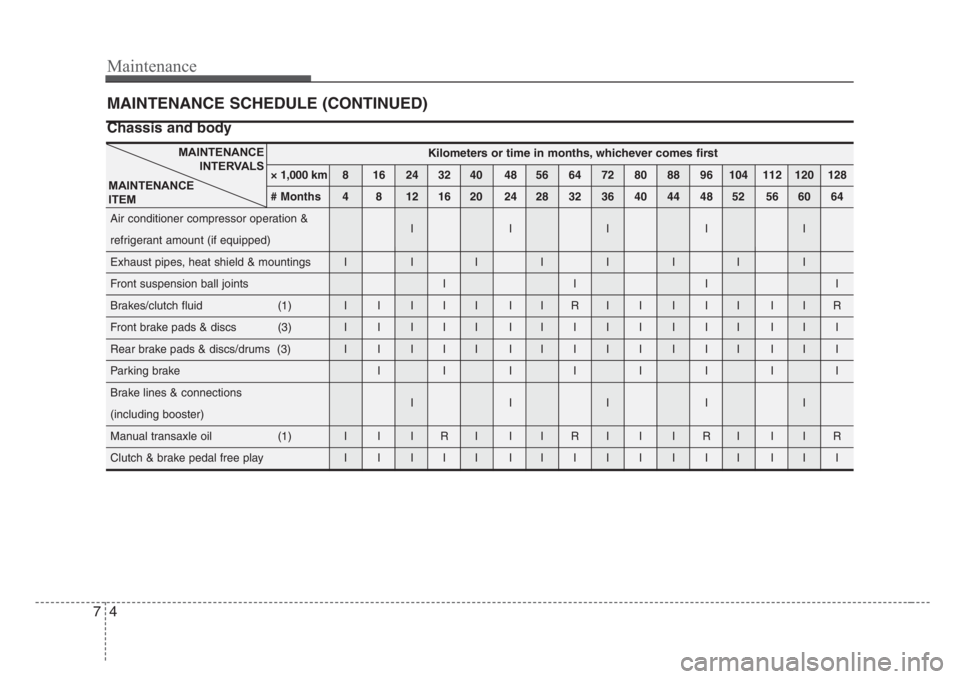
Maintenance
4 7
MAINTENANCE SCHEDULE (CONTINUED)
Chassis and body
Kilometers or time in months, whichever comes first
× 1,000 km 8 16 24 32 40 48 56 64 72 80 88 96 104 112 120 128
# Months4 8 12 16 20 24 28 32 36 40 44 48 52 56 60 64
Air conditioner compressor operation &
IIIII
refrigerant amount (if equipped)
Exhaust pipes, heat shield & mountings I IIIIIII
Front suspension ball joints I I I I
Brakes/clutch fluid (1) I I I I I I I RIIIII IIR
Front brake pads & discs (3) I I I I I IIIIIIII III
Rear brake pads & discs/drums (3) I I I I I IIIIIIII III
Parking brake I I IIIIII
Brake lines & connections
IIIII
(including booster)
Manual transaxle oil (1) I I I R I I I R I I I R I I I R
Clutch & brake pedal free play I I I I I IIIIIIII III
MAINTENANCE
INTERVALS
MAINTENANCE
ITEM